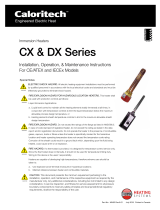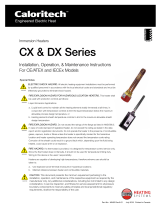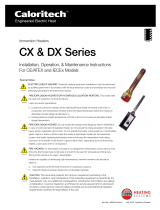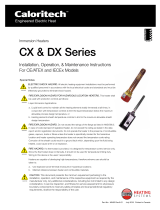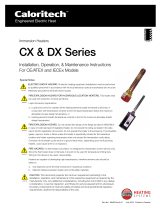Page is loading ...

Chromalox
®
DIVISION
4
SECTION
TPR/TPF
SALES
REFERENCE
DATE
SERVICE REFERENCE
Installation, Operation
and
Maintenance Instructions
PD437-4
161-074306-001
SEPTEMBER, 1998
(Supersedes PD437-3)
© 2010 Chromalox, Inc.
Tuff-Tube
™
One and Tuff-Tube
™
Three
PFA Teflon
®
Thermoplastic Covered Metal Sheath
Over-the-Side Immersion Heater
TUFF-TUBE
™
ONE (TPR)
Dimensions (In.)
Model Watts Volts Phase
A B* C** D
TPR-101
1000
120 1
13 6 7 15
TPR-102 240 1
TPR-202
2000
240 1
21 12 9 23
TPR-204 480 1
TPR-302
3000
240 1
26 17 9 28
TPR-304 480 1
TPR-402
4000
240 1
31 22 9 33
TPR-404 480 1
TPR-602
6000
240 1
42 33 9 44
TPR-604 480 1
TPR-802
8000
240 1
53 44 9 55
TPR-804 480 1
Specifications — Type TPR — Figure 1
TUFF-TUBE
™
THREE (TPF)
Dimensions (In.)
Model Watts Volts Phase
A B* C** D
TPF-302
3000
240 3
20 11 9 22
TPF-304 480 3
TPF-402
4000
240 3
23 14 9 25
TPF-404 480 3
TPF-602
6000
240 3
30 21 9 32
TPF-604 480 3
TPF-802
8000
240 3
37 28 9 39
TPF-804 480 3
TPF-1002
10000
240 3
44 35 9 46
TPF-1004 480 3
Specifications — Type TPF — Figure 2
*B Dimension is heated section. **C Dimension is cold section.
*B Dimension is heated section. **C Dimension is cold section.
A
C
B
D
7/8 Dia. each side
for 1/2 in. conduit
Tank Lip
Plastic guard cover removed
for illustration purposes.
D
Plastic guard cover removed
for illustration purposes.
Mounting Hole Location
7/8 Dia. each side
for 1/2 in. conduit
Tank Lip
A
C
B
Mounting Hole Location

GENERAL
WARNING: This heater is not intended for use in
hazardous atmospheres where flammable vapors,
gases, liquids or other combustible atmospheres are
present as defined in the National Electrical Code.
Failure to comply can result in explosion or fire.
Chromalox type TPR and TPF over-the-side immersion heaters
are especially suited for heating corrosive solutions to 212˚F.
WARNING: It is the responsibility of the purchaser of
the heater to make the ultimate choice of sheath
material based upon his knowledge of the chemical
composition of the corrosive solution, character of
the materials entering the solution, and controls
which he maintains on the process. Chromalox can-
not warrant any electric immersion heater against
failure by sheath corrosion if such failure is the result
of operating conditions beyond our control.
1. Heater Construction Characteristics
A. High quality resistance wire held in place by compacted mag-
nesium oxide in stainless steel sheath and thermoplastic coated.
B. Medium Watt Density — 20 watts per sq. inch.
C. Light weight and low profile.
D. Removable polypropylene guard is standard.
E. PVC mounting bracket is standard for easy installation.
F. Element terminals are encapsulated with a self-hardening
vapor barrier.
G. Manual reset cutout to shut off heater in an overtempera-
ture condition is standard.
WARNING: Users should install adequate controls
and safety devices with their electric heating equip-
ment. Do not use the overtemperature control as a
level control device, damage may result to the coat-
ing should an overtemperature condition exist.
Where the consequences of failure may be severe,
back-up controls are essential. Although the safety
of the installation is the responsibility of the user,
Chromalox will be glad to make equipment recom-
mendations.
WIRING
WARNING: Hazard of Electric Shock. Any installation
involving electric heaters must be effectively ground-
ed in accordance with the National Electrical Code.
1. Electrical wiring to heater must be installed in accordance
with the National Electrical Code and local codes by a quali-
fied person.
2. Wire heater with manual reset thermal cutout as shown in
Figures 3 thru 7.
NOTE: 1) Manual reset thermal cutout rating 25 Amps 120-277
Vac; 2) Customer supplied thermostat wiring not shown.
3. WARNING: Entrance of corrosive fumes and
vapors into the enclosure may damage internal
parts. Use liquid-tight fitting and liquid-tight
conduit for wiring entrance. Unused conduit
opening must be sealed with snap-in plug pro-
vided. Assemble terminal cover tightly.
INSTALLATION
WARNING: Hazard of Electric Shock. Disconnect all
power before installing heater.
1. CAUTION: Do not scrape or scratch thermoplastic coating
on heating elements. Damage could result.
2. Before installing the type TPR and TPF heater, inspect it for
possible damage which may have occurred during shipment.
Also, check to insure the line voltage is the same as that on the
nameplate.
3. WARNING: Mount heater in the tank so the liq-
uid level will always be above the effective heated
portion of the heater. If heater is not properly sub-
merged, it will overheat and damage the heating
elements and create a possible fire due to exces-
sive sheath temperature. (NOTE: Level indicator on
plastic guard is 2” above heated section. Do not use the overtem-
perature control as a level control device, damage may result to
the coating should an overtemperature condition exist.)
4. In an electroplating operation the heaters are not, under any
circumstance, to be placed between the electrodes and the work.
5. DANGER: Hazard of Fire and Toxic Fumes. Since
these heaters are capable of developing high temperatures,
care should be taken to maintain liquid level above heated
portion (Dimension B of Figures 1 and 2) of heater.
OPERATION
1. Do not operate heater at voltages in excess of that stamped on
the heater since excess voltage will shorten heater life.
2. Always maintain a minimum of 2” of solution above the heat-
ed portion of the element to prevent exposure of the effective
heated length. If the heater is not properly submerged, it may
overheat and shorten heater life. Do not operate heater if dry.
(Note: Heated portion of element is Dimension B of Figures 1
and 2). Do not use the overtemperature control as a level control
device, damage may result to the coating should an overtempera-
ture condition exist.
3. Sludge should not be allowed to build-up to the point where it
contacts heater as this can lead to premature heater failure.
4. Maximum recommended process temperature is 212˚F.
5. If manual reset cutout trips, disconnect power to heater and
check for cause of overheat condition. Check heater elements and
coating for possible damage due to an overheat condition. Correct
condition, then remove heater terminal cover and push black reset
button to reset the cutout. Assemble terminal cover tightly before
re-energizing heater.
MAINTENANCE
WARNING: Hazard of Electric Shock. Disconnect all
power before servicing or replacing heater.
1. Heaters should be checked periodically for coating and corro-
sive buildup and cleaned if necessary.
2. Tank should be checked regularly for sediment around the end
of heater as this sediment can act as an insulation and shorten
heater life.
3. Note: Before thermoplastic heater is removed from solution, it
should be allowed to cool from 15 to 20 minutes.
4. CAUTION: Do not scratch or scrape elements when clean-
ing. Cleaning should be done chemically.
5. To remove plastic guard - disconnect all plastic hardware
attachments on guard assembly.

Cutout
Ground
120V or 240V
Control Circuit
Factory
Field
Green
Line Voltage
3 Pole Contactor
(Customer Supplied)
1
2
1
3
2
3
C1
C2
1
2
Cutout
Ground
Factory
Field
Green
120V Line Voltage
C2
C1
WIRING DIAGRAMS
1
2
C2
C1
Line Voltage
2 Pole Contactor
(Customer Supplied)
Cutout
Ground
Factory
Field
Green
120V or 240V
Control Circuit
Figure 3
Figure 4
Figure 5
Single Phase (All TPR Heaters)
Alt. Single Phase (TPR-101 Only)
Three Phase (TPF-302, -304, -402, -404)

Cutout
Ground
120V or 240V
Control Circuit
Factory
Field
Green
Line Voltage
3 Pole Contactor
(Customer Supplied)
1
2
3
1
2
3
C1
C2
2150 N. RULON WHITE BLVD., OGDEN, UT 84404
Phone: 1-800-368-2493 www.chromalox.com
TA - Q0 - EF
Litho in U.S.A.
WIRING DIAGRAMS
Figure 6 Three Phase (TPF-602, -604, -802, -804, -1002, -1004)
Cutout
Ground
120V or 240V
Control Circuit
Factory
Field
Green
Line Voltage
2 Pole Contactor
(Customer Supplied)
C1
C2
1
2
1
3
2
3
Figure 7 Single Phase (TPF Rated 3kW and 4kW, 240 or 480 Volt)
Limited Warranty:
Please refer to the Chromalox limited warranty applicable to this product at
http://www.chromalox.com/customer-service/policies/termsofsale.aspx.
/



